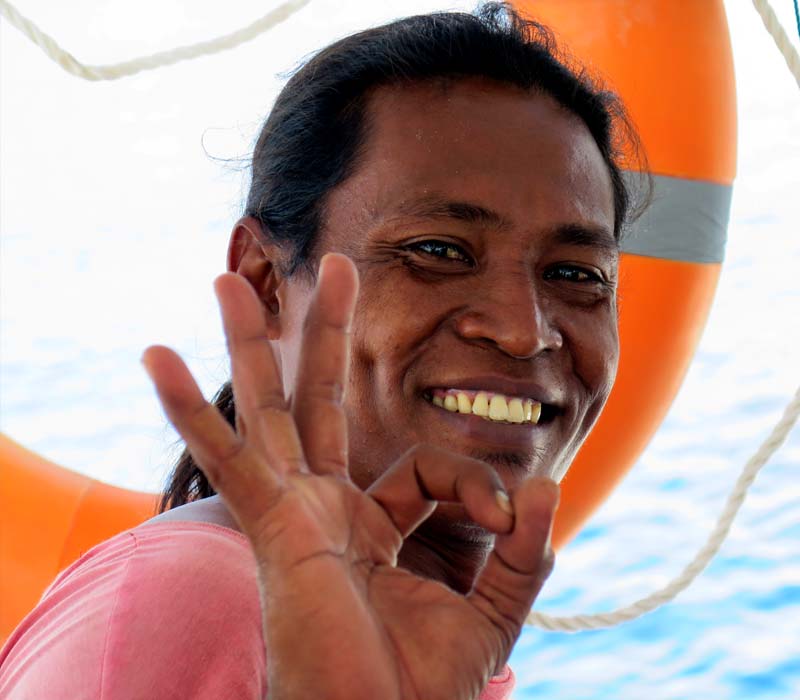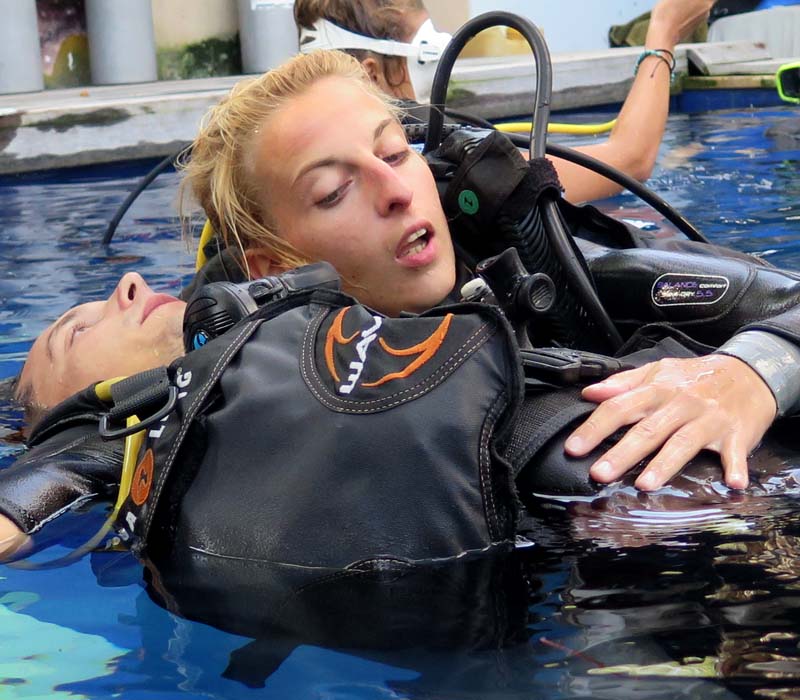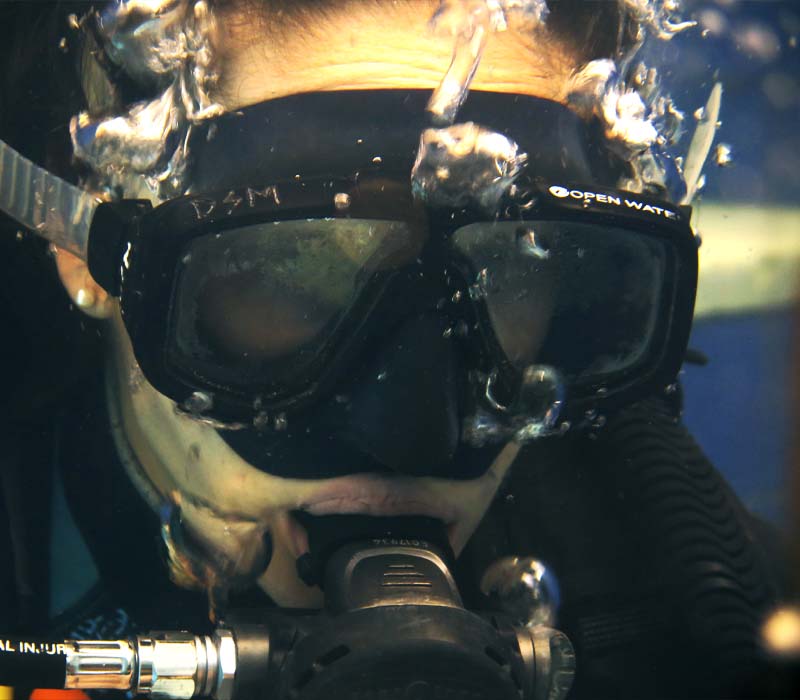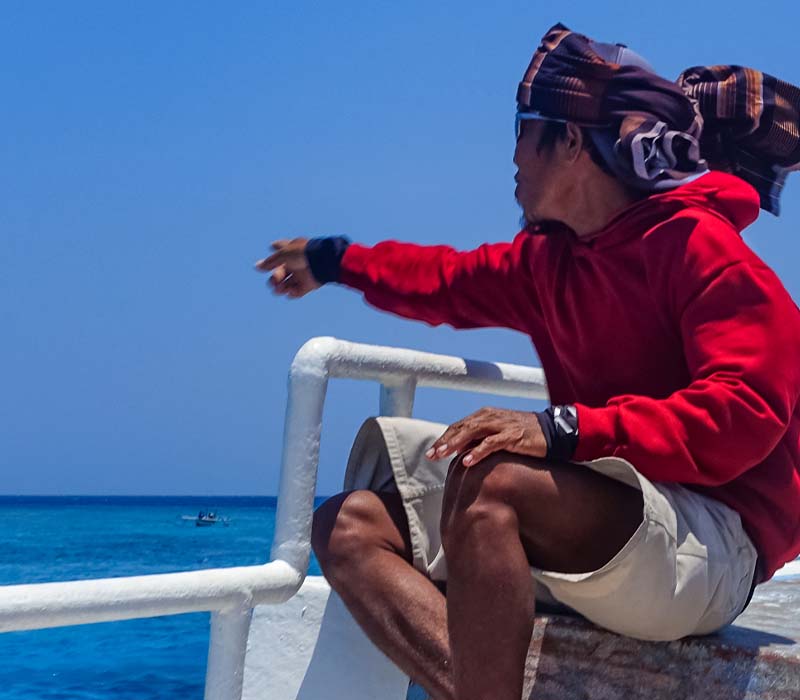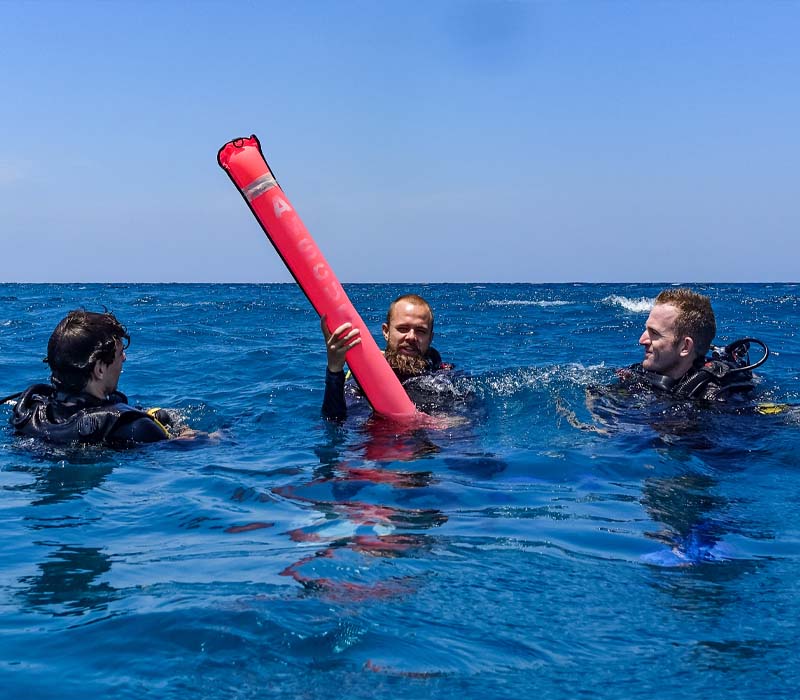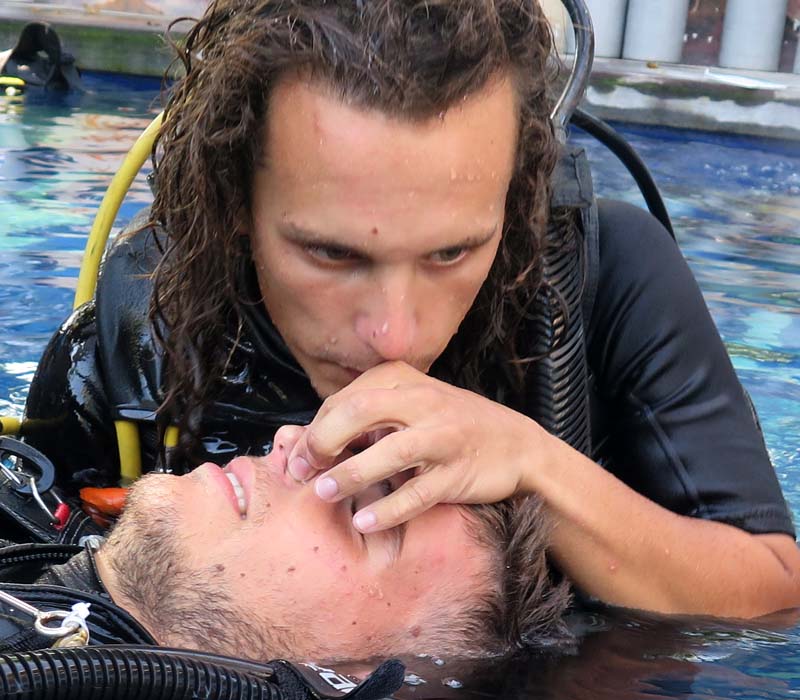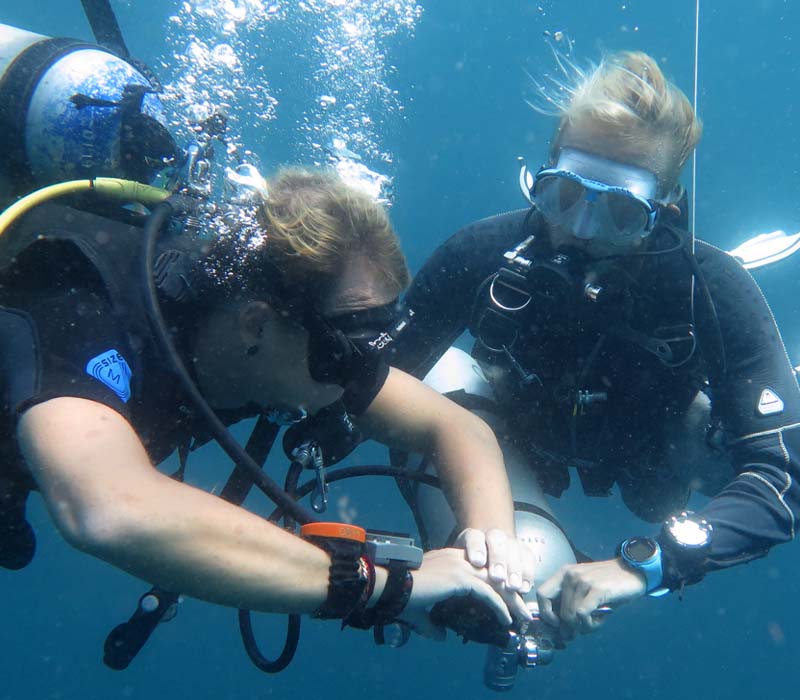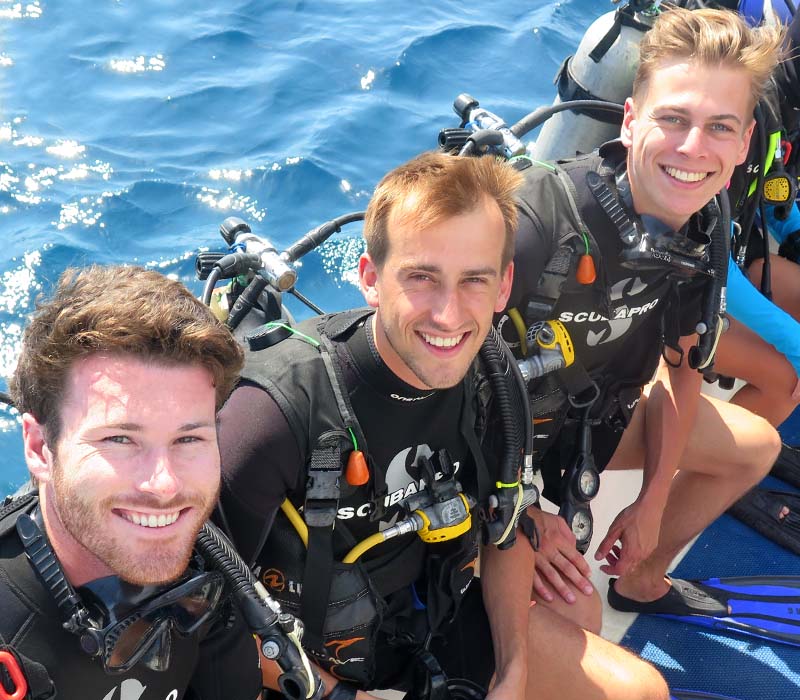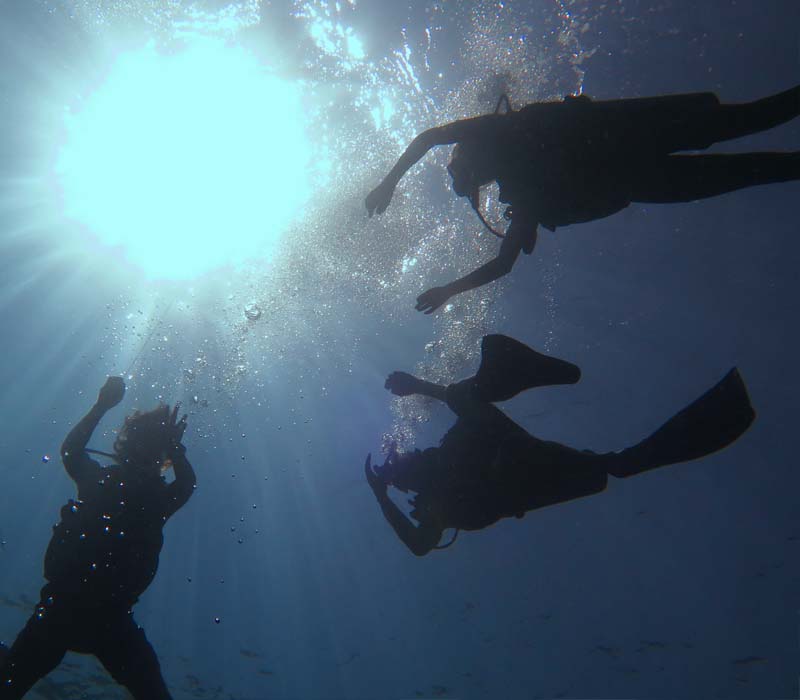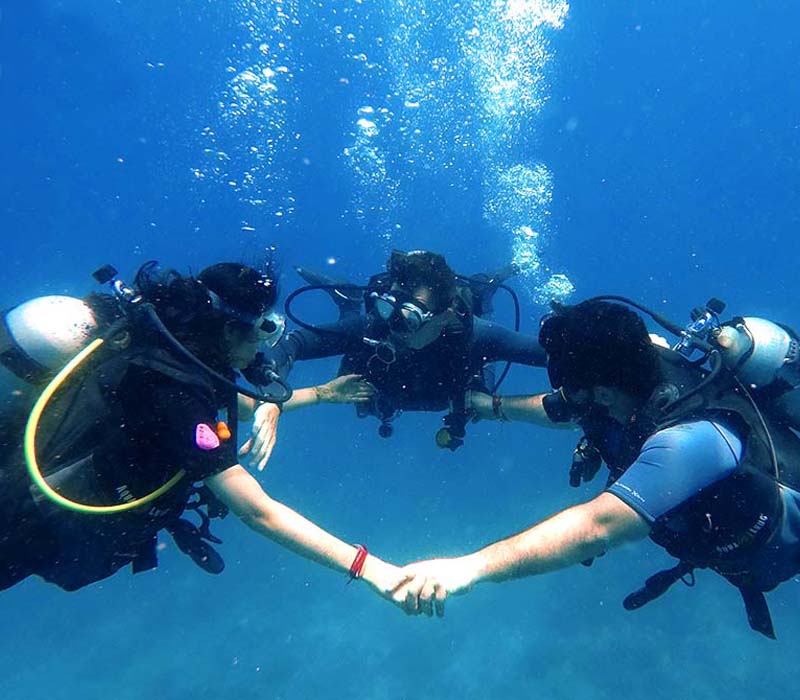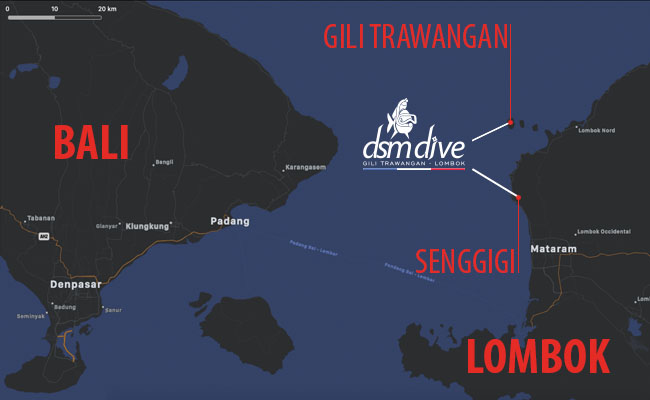EFR & RESCUE DIVER
LEVEL 3
PADI | DSM DIVE | The way you want to dive
EFR & RESCUE DIVER – LEVEL 3
The Rescue Diver Course is considered the most challenging of the PADI program and gives you another perspective on your diving activities.
To be able to react correctly, you must be certified as an “Emergency First Responder” (EFR) before starting your Rescue course.
We can organize the two courses independently or as a package.
EMERGENCY FIRST RESPONDER COURSE
Emergency First Response training focuses on building confidence in lay rescuers and increasing their willingness to respond when faced with a medical emergency.
Course participants learn to follow simple steps for emergency care and practice applying skills in a non-stressful learning environment. All courses are supported by self-study manuals, videos, and quick reference cards to enhance learning and allow you to start learning right away EFR Courses meet the CPR and first aid training requirements for the PADI Rescue Diver Course and all professional-level ratings. Most PADI Instructors are also Emergency First Response Instructors. The following EFR courses are based on internationally recognized medical guidelines for emergency care.
RESCUE DIVER COURSE
Do you want to learn how to prevent and manage problems in the water? The PADI Rescue Diver Course in Gili Trawangan helps you to be become more confident in diving, knowing that you can help others if needed. It sharpens your senses, how to recognize and react to serious situations underwater and how to solve problems. Learning how to be a better buddy as a Rescue Diver will give you a lot of recognition in the diving community.
The PADI Rescue Diver course is a lot of fun, even if you train for serious situations. It makes the PADI Rescue Diver one of the most challenging but also most rewarding diver courses.
You need to have Emergency First Response Primary and Secondary Care (CPR and First Aid) within the previous 24 months. You can complete this training with DSM Dive during your Rescue Diver Course. You can also learn with DSM Dive how to become a PADI Emergency Oxygen Provider.
The PADI Rescue Diver course prepares you to deal with dive emergencies, minor and major, using a variety of techniques. Through knowledge development and rescue exercises, you learn what to look for and how to respond. During rescue scenarios, you put into practice your knowledge and skills.
The theoretical part of the PADI Rescue Diver Course takes place in our DSM Dive Center on Gili Trawangan or Lombok. The practical part of your PADI Rescue Diver will be in our pool in Gili Trawangan and in the open water around the Gili islands. Departure with the boat to the dive sites of the Gili Islands is at our dive school DSM Dive in Gili Trawangan.
RESCUE DIVER COURSE
- 4 DAYS
- TEACHING MATERIAL
- THEORY & POOL TRAINING
- 4 SCENARIOS
- ALL EQUIPMENT
- DIVE INSTRUCTOR
- MARINE PARK FEE NOT INCLUDED
EFR COURSE
- 1 DAY
- TEACHING MATERIAL
- THEORY COURSES
- PRACTICAL COURSE & SCENARIOS
- ALL EQUIPMENT
- EFR INSTRUCTOR
- MARINE PARK FEE NOT INCLUDED
PACKAGE EFR & RESCUE DIVER COURSES
- 5 DAYS
- EFR & RESCUE DIVER TEACHING MATERIAL
- EFR & RESCUE THEORY
- EFR PRACTICAL COURSES & SCENARIOS
- RESCUE POOL TRAINING
- 4 SCENARIOS
- ALL EQUIPMENT
- EFR & DIVE INSTRUCTOR
- MARINE PARK FEE NOT INCLUDED
MARINE PARK FEE
All divers are required to pay a one-off Marine Park fee of 100 000 IDR and a Gili Eco Trust funding of IDR 50 000 IDR. This one-time payment of 150 000 IDR will be paid in cash at the dive shop upon your arrival.
WHAT WILL YOU LEARN ?
YOUR EMERGENCY RESPONDER COURSE
The program is divided into three parts, Theory, Practical Training and Scenarios.
For each module, you will have a debriefing and practical training with your instructor. Step by step, you will realize more complex scenarios to drill to react properly and avoiding hurt yourself or creating an additional accident.
Primary Care (CPR)
This course teaches you the steps and techniques for handling life-threatening emergencies. You’ll practice eight skills for aiding patients who aren’t breathing, have any heartbeat, may have a spinal injury, maybe in shock, or who may have serious bleeding. You’ll learn how to perform CPR and continue to monitor the patient so that you provide every possible chance of survival while waiting for emergency medical services to arrive.
Secondary Care (First Aid)
Because many medical conditions are not life-threatening and emergency medical services are sometimes delayed or unavailable, this course teaches you how to provide first aid that eases pain and reduces the risk of further harm. You’ll learn to assess a variety of injuries and illnesses and practice bandaging and splinting.
Care for Children
This course allows participants to learn, practice, and apply emergency care skills specific to helping infants and children with medical emergencies. It’s designed for those who work with children or are likely to have to respond to emergencies involving youngsters. This course is often integrated with Primary Care (CPR) and Secondary Care (First Aid) courses.
CPR & AED
This course focuses on CPR training and teaching participants how to use an AED (automated external defibrillator). When workplace or governmental requirements specify this training, the CPR & AED course meets the need. This course is often integrated into First Aid at Work programs.
First Aid at Work
In some areas, such as Great Britain, Australia, and Canada, governmental regulations call for enhanced CPR and first aid training for the workplace. First Aid at Work programs designed for these areas includes additional topics and skills to meet requirements while following the easy-to-learn EFR approach to training.
THE OBJECTIVES
YOU WILL LEARN HOW TO DO AN EVALUATION OF AN ACCIDENT SCENE.
YOU WILL LEARN HOW TO SECURE YOURSELF AND PEOPLE AROUND ON AN ACCIDENT SCENE.
YOU WILL LEARN HOW PRIORITIZE ACTIONS AND HOW TO MAKE A RESCUE PLAN.
YOU WILL LEARN HOW TO COLLABORATE AND DISPATCH TASKS FOLLOWING AN EMERGENCY PLAN.
YOU WILL LEARN HOW TO AVOID ADDITIONAL ACCIDENTS.
YOU WILL LEARN HOW TO COLLECT ALL THE INFORMATION AND HOW TO CALL EMERGENCIES PROPERLY.
YOU WILL LEARN ALL THE BASIC MEDICAL TECHNICS THAT CAN SAVE LIFE.
YOU WILL LEARN HOW TO REACT FAST BUT NOT IN A HURRY.
YOUR RESCUE DIVER COURSE
The program is divide into three parts, Theory, Confined Water, and Open Water Dive Scenario.
The PADI Rescue Diver course prepares you to deal with dive emergencies, minor and major, using various techniques. Through knowledge development and rescue exercises, you learn what to look for and how to respond. During rescue scenarios, you put into practice your knowledge and skills.
Theory
You will pass through the five chapters of theory with your instructor, and he will answer all your questions. Step by step, you will learn more profound about the psychology, evaluation of the scene, organization. You need to know how to react the right way to an emergency situation.
Confined Water
In a pool, we will drill you on different rescue techniques. Once you are master it, your instructor will put in place different micro scenarios, evaluate and correct your reaction, organization, skills to train you for the Dive Scenarios.
Dive Scenarios
In the pool and in the open ocean, from the boat, from the beach, your instructor will put in place different rescue scenarios you will have to react right. The final part is to put you as close as possible as reality in a simulation of different emergency scenarios in actual ocean conditions.
THE PREREQUISITES
AT LEAST 12 YEAR OLD (if you are between 12 and 14 years old, you will earn the “Junior Rescue Diver Certification”).
AT LEAST BEING PADI (JUNIOR) ADVENTURE DIVER – MUST HAVE COMPLETED THE UNDERWATER NAVIGATION ADVENTURE DIVE OR AN EQUIVALENT LEVEL OR ADVANCED OPEN WATER DIVER.
BEING EFR PRIMARY AND SECONDARY CARE TRAINED WITHIN 24 MONTHS. MAY COMPLETE TRAINING ALONG WITH RESCUE DIVER COURSES.
- MEDICAL CLEARANCE FOR ANY PRE-EXISTING CONDITIONS. [ DOWNLOAD THE MEDICAL FORM ]
PLEASE SEND US AN EMAIL, CALL US OR DROP BY AT DSM DIVE TO MAKE YOUR RESERVATION AT LEAST 24 HOURS IN ADVANCE.
THERE ARE STRICT RESTRICTIONS WHEN FLYING TO ALTITUDE AFTER DIVING. YOU NEED TO WAIT FOR A MINIMUM OF 18 HOURS AFTER YOUR LAST DIVE, SO PLEASE PLAN YOUR FLIGHTS AND MOUNTAIN HIKING TRIPS ACCORDINGLY.
BOOKING
In the dive industry, the booking has to be completed at least one day before the course. Diving is not too complicated, but it takes a lot of logistical support and organization. Each diver has to come in person to the dive center to complete the pre-course paperwork and to receive the teaching material. With your instructor, we will explain your personal plan and how the course will proceed.
HOW TO CONTINUE ON DIVING ?
Continue with the PADI Specialty Course or become a professional diver with the PADI Divemaster Training Course.
In the PADI Specialty Course, you can choose from a list of Specialty Dives where you want to hone your skills and increase your confidence and Knowledge…
In the PADI Divemaster Training Course, you will learn to become a professional diver to take charge certified diver and to assist Instructors, and it’s the first step into the diving industry.
Read more :
DIVE TRIP

